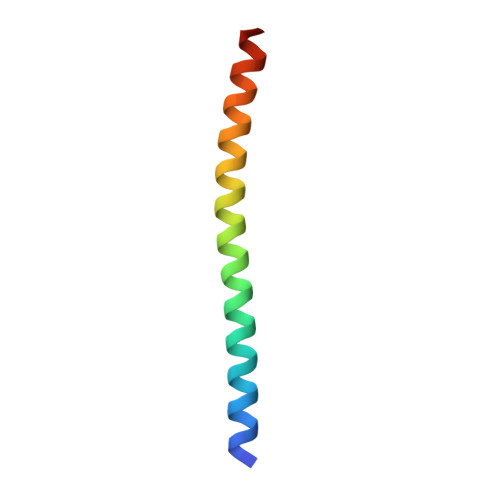Improving Coiled Coil Stability While Maintaining Specificity by a Bacterial Hitchhiker Selection System.
Kukenshoner, T., Wohlwend, D., Niemoller, J., Dondapati, P., Speck, J., Adeniran, A.V., Nieth, A., Gerhardt, S., Einsle, O., Muller, K.M., Arndt, K.M.(2014) J Struct Biol 186: 335
- PubMed: 24631970
- DOI: https://doi.org/10.1016/j.jsb.2014.03.002
- Primary Citation of Related Structures:
4C7N - PubMed Abstract:
The design and selection of peptides targeting cellular proteins is challenging and often yields candidates with undesired properties. Therefore we deployed a new selection system based on the twin-arginine translocase (TAT) pathway of Escherichia coli, named hitchhiker translocation (HiT) selection. A pool of α-helix encoding sequences was designed and selected for interference with the coiled coil domain (CC) of a melanoma-associated basic-helix-loop-helix-leucine-zipper (bHLHLZ) protein, the microphthalmia associated transcription factor (MITF). One predominant sequence (iM10) was enriched during selection and showed remarkable protease resistance, high solubility and thermal stability while maintaining its specificity. Furthermore, it exhibited nanomolar range affinity towards the target peptide. A mutation screen indicated that target-binding helices of increased homodimer stability and improved expression rates were preferred in the selection process. The crystal structure of the iM10/MITF-CC heterodimer (2.1Å) provided important structural insights and validated our design predictions. Importantly, iM10 did not only bind to the MITF coiled coil, but also to the markedly more stable HLHLZ domain of MITF. Characterizing the selected variants of the semi-rational library demonstrated the potential of the innovative bacterial selection approach.
Organizational Affiliation:
Molecular Biotechnology, Institute for Biochemistry and Biology, University of Potsdam, Potsdam, Germany; Institute for Biology III, University of Freiburg, Freiburg im Breisgau, Germany.
















